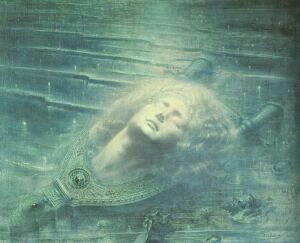 Perhaps Heidegger's orientation is
truly metaphysical and he describes a kind of mind more original
even than life itself, which surfaces only finally through human
self-awareness. Or perhaps Heidegger was so impelled to distill the
comprehensive essence of western thought that he allowed himself to
be drawn into how this could be best expressed, leaving others to
struggle with the aspects of reality to which western thought
cannot do justice. For though philosophy in its history has ranged
over many subjects, it could come no closer to most than to make
for them 'explanatory pictures'. Such pictures cannot be considered
to hold truth for a thinking grounded in temporality.
Heidegger may therefore have deliberately neglected the apparent
range of philosophy. A third possibility is that Heidegger's
omissions are justifiable on grounds which can only become evident
as thinking more adequately appropriates its native temporality -
grounds perhaps lying between the metaphysical and the
historical.
Perhaps Heidegger's orientation is
truly metaphysical and he describes a kind of mind more original
even than life itself, which surfaces only finally through human
self-awareness. Or perhaps Heidegger was so impelled to distill the
comprehensive essence of western thought that he allowed himself to
be drawn into how this could be best expressed, leaving others to
struggle with the aspects of reality to which western thought
cannot do justice. For though philosophy in its history has ranged
over many subjects, it could come no closer to most than to make
for them 'explanatory pictures'. Such pictures cannot be considered
to hold truth for a thinking grounded in temporality.
Heidegger may therefore have deliberately neglected the apparent
range of philosophy. A third possibility is that Heidegger's
omissions are justifiable on grounds which can only become evident
as thinking more adequately appropriates its native temporality -
grounds perhaps lying between the metaphysical and the
historical.
VIII |
|
 Perhaps Heidegger's orientation is
truly metaphysical and he describes a kind of mind more original
even than life itself, which surfaces only finally through human
self-awareness. Or perhaps Heidegger was so impelled to distill the
comprehensive essence of western thought that he allowed himself to
be drawn into how this could be best expressed, leaving others to
struggle with the aspects of reality to which western thought
cannot do justice. For though philosophy in its history has ranged
over many subjects, it could come no closer to most than to make
for them 'explanatory pictures'. Such pictures cannot be considered
to hold truth for a thinking grounded in temporality.
Heidegger may therefore have deliberately neglected the apparent
range of philosophy. A third possibility is that Heidegger's
omissions are justifiable on grounds which can only become evident
as thinking more adequately appropriates its native temporality -
grounds perhaps lying between the metaphysical and the
historical. Perhaps Heidegger's orientation is
truly metaphysical and he describes a kind of mind more original
even than life itself, which surfaces only finally through human
self-awareness. Or perhaps Heidegger was so impelled to distill the
comprehensive essence of western thought that he allowed himself to
be drawn into how this could be best expressed, leaving others to
struggle with the aspects of reality to which western thought
cannot do justice. For though philosophy in its history has ranged
over many subjects, it could come no closer to most than to make
for them 'explanatory pictures'. Such pictures cannot be considered
to hold truth for a thinking grounded in temporality.
Heidegger may therefore have deliberately neglected the apparent
range of philosophy. A third possibility is that Heidegger's
omissions are justifiable on grounds which can only become evident
as thinking more adequately appropriates its native temporality -
grounds perhaps lying between the metaphysical and the
historical. |
 |
But a contemporary Heidegger
scholar torn between a 'metaphysical'
and a 'historical' interpretation of his work might experience it
in the fashion of the well known 'Necker cube' optical illusion -
where perception oscillates between seeing outward and inward
projections of perspectival depth. Heidegger may not have intended
such an effect, but
Nietzsche's aphorisms, in their contexts, are
meant thus
to bedevil interpretation. The same might be said for some of the
later
Wittgenstein's fragments. Thinkers in our time must regard
these kinds of effects as more than confusions to be overcome -
because they exhibit one of the ways thinking has entered the
element of temporality.
|
|
Thus the insistent
conceptual
'hammer'
with which Nietszche purports to
philosophize breaks up even his own
ideas into myriad metaphors -
themselves often also questionable -
which overflow any consistent
species of comprehension.
|
In
Nietzsche
and Wittgenstein,
equivocal or polyvalent
propositions use the space which would hold the experience of an
answer to confine, instead, the experience of a question. The very
oscillating instability of such meanings, particularly when we find
them deployed in full scale mosaics, as in Nietzsche, teach us to
read in a way that no longer simply accumulates structures of
meaning, but involve us in superposed and instantaneously shifting
fields of potential. Nietzsche thus perhaps deserves credit for
anticipating even how today's quantum physicists try to
think.
|
|
The
mirth whereof
so larded with my matter, that neither singly can be manifested. |
When
Nietzsche
raises ideas into a suspension
where they put each other in question, put him in
question,
and challenge us to put ourselves in question, he
can be
understood to eccentrically conjoin the three movements of
transcendence described above. The overall impression is one of
play.
Wittgenstein's later reliance on the notion of games
too, cannot be separated from connotations of play, while Steiner's account of human
development gives play
near sacramental status.
|










